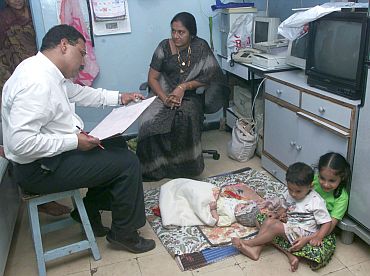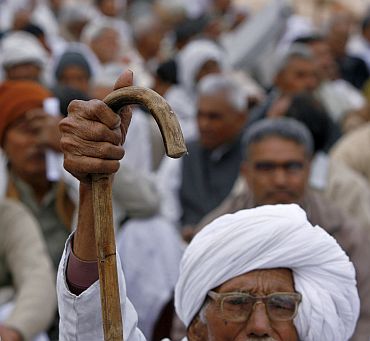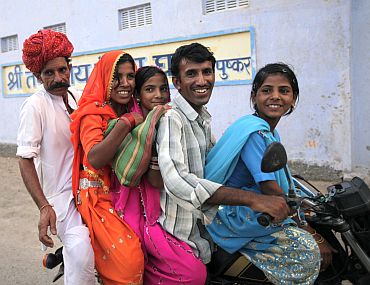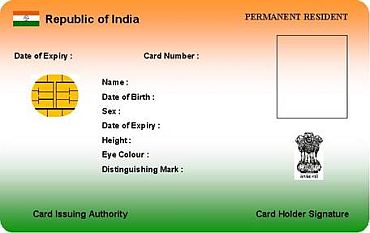Photographs: Stringer India/Reuters
President Pratibha Patil was the first of a billion-plus population in the country to be counted on Wednesday as lakhs of enumerators fanned out in a gigantic effort to document every citizen over the next three weeks in the world's second largest census.
Kickstarting the second phase of Census 2011, a woman enumerator went to Rashtrapati Bhavan and collected information for a questionnaire from the country's first citizen.
The decennial exercise will cover the entire country. India has an estimated 1.17 billion population.
The biggest census ever to be attempted in human history beagn in April last year. The 15th national census exercise, which will see over 25 lakh officials capturing the socio-economic-cultural profile of its citizens, will also seek information for the creation of the National Population Register. Here is all that you need to know about the census...
What is census? How is it useful?
The census is the most credible source of information on demography (population characteristics), economic activity, literacy and education, housing and household amenities, urbanisation, fertility and mortality, Scheduled Castes and Scheduled Tribes, language, religion, migration, disability and many other socio-cultural and demographic data since 1872.
Census 2011 will be the 15th national census of the country. This is the only source of primary data at village, town and ward level. It provides valuable information for planning and formulation of polices for central and state governments and is widely used by national and international agencies, scholars, business people, industrialists, and many more.
The delimitation/reservation of constituencies -- parliamentary/assembly/panchayats and other local bodies is also done on the basis of the demographic data thrown up by the census. The census is the basis for reviewing the country's progress in the past decade, monitoring the on-going schemes of the government and most importantly, plan for the future.
...
Information Courtesy: CensusIndia.gov.in
Census info is absolutely confidential
Image: Image used for representational purpose onlyPhotographs: Reuters
What is the National Population Register? What is its use?
The NPR would be a register of usual residents of the country. The NPR will be a comprehensive identity database that would help in better targeting of the benefits and services under the government schemes/programmes, improve planning and help strengthen security of the country. This is being done for the first time in the country.
How will both these exercises be conducted?
The census is a statutory exercise conducted under the provisions of the Census Act 1945. The NPR is being created under the provisions of the Citizenship Act and Rules.
Census processThe census process involves visiting each and every household and gathering particulars by asking questions and filling up census forms. The information collected about individuals is kept absolutely confidential. In fact, this information is not accessible even to courts of law.
After the fieldwork is over the forms are transported to data processing centres located at 15 cities across the country. The data processing will be done using sophisticated software called Intelligent Character Recognition Software. This technology was pioneered by India in Census 2001 has become the benchmark for censuses all around the globe.
This involves the scanning of the census forms at high speed and extracting the data automatically using computer software. This revolutionary technology has enabled the processing of the voluminous data in a very short time and saving a huge amount of manual labour and cost.
National population register process
Details such as name, date of birth, sex, present address, permanent address, names of father, mother and spouse etc will be gathered by visiting each and every household. All usual residents will be eligible to be included irrespective of their nationality. Every household will be given an acknowledgement slip at the time of enumeration.
The data will then be entered into computers in the local language of the state as well as in English. Once this database has been created, biometrics such as photograph, 10 fingerprints and probably iris information will be added for all persons aged 15 years and above.
This will be done by arranging camps at every village and at the ward level in every town. Each household will be required to bring the acknowledgement slip to such camps. Those who miss these camps will be given the opportunity to present themselves at permanent NPR centres to be set up at the tehsil/town level.
Every person gets a unique ID
Image: Image used for representational purpose onlyPhotographs: Adnan Abidi/Reuters
In the next step, the data will be printed out and displayed at prominent places within the village and ward for the public to see. The list, authenticated by the ward committees, will then be sent to the Unique Identity Authority of India for de-duplication and issue of UID numbers.
All duplicates will be eliminated at this stage based on comparison of biometrics. unique ID numbers will also be generated for every person. The cleaned database along with the UID number will then be sent back to the Office of the Registrar General and Census Commissioner, India and would form the National Population Register.
Will an identity card be given?
The NPR would have the data of every person enumerated during the census operations irrespective of age. It would also have the biometric data and UID number of every person of age 15 years and above. National identity cards will be given in a phased manner to all usual residents.
Who will collect the Information?
Government servants duly appointed as enumerators will visit each and every house and collect the information required. They will carry an identity card as well as an appointment letter. In case of need you may ask them to show these documents. The local tehsildar can also be contacted in this regard.
The information you need to give
Image: Image used for representational purpose onlyPhotographs: Jorge Silva/Reuters
What information will be collected?
Two forms will be canvassed in each household. The first relates to the house-listing and housing census. In this, 35 questions relating to building material, use of houses, drinking water, availability and type of latrines, electricity, possession of assets etc. will be canvassed. The second form relates to the National Population Register. In this the following will be canvassed:
- Name of the person
- Gender
- Date of birth
- Place of birth
- Marital status
- Name of father
- Name of mother
- Name of spouse
- Present address
- Duration of stay at present address
- Permanent address
- Occupation
- Nationality as declared
- Educational qualification
- Relationship to head of family
Will my Information be disclosed to anybody?
All information collected under the census is confidential and will not be shared with any agency -- government or private. Certain information collected under the NPR will be published in the local areas for public scrutiny and invitation of objections. This is in the nature of the electoral roll or the telephone directory. After the NPR has been finalised, the database will be used only within the government.
How do I know census dates?
Image: Image used for representational purpose onlyPhotographs: Arko Datta/Reuters
How will I know that the census is being conducted?
Advertisements will be published in local newspapers and in the radio/electronic media. Apart from this, the census enumerators will be visiting your house in person. They will be affixing small census stickers on the doorway of houses in which census has been completed. These will indicate that they have commenced operations in your area.
False information can invite penalties
Image: Image used for representational purpose onlyThe local tehsildar/ward officer of your area is the designated officer. In case of need you can also contact the Collector/DC/DM of your district or the commissioner of your town.
How do I ensure that the information given by me is being correctly entered?
The NPR form has to be signed by you. In case you require, ask the enumerator to read it out to you and then affix your signature/thumb impression. In any case do ascertain that the details are correctly entered.
Do I need to show any documents to the enumerator?
The enumerator will take down all particulars as given by you. You are not required to show any proof. However, be cautioned that it is expected that you will provide correct and authentic information. You are also signing to this effect. The provision of false information can invite penalties under the Census and Citizenship Acts.
What is the link between NPR and Unique ID Authority of India?
The data collected in the NPR will be subjected to de-duplication by the UIDAI. After de-duplication, the UIDAI will issue a UID number. This UID number will be part of the NPR and the NPR cards will bear this UID number. The Office of Registrar General and Census Commissioner will do the maintenance of the NPR database and updating subsequently.






article